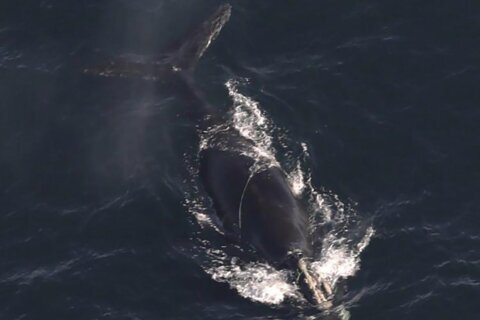RENO, Nev. (AP) — In what will be a tiny big-game hunt for some of the largest animals in North America, Nevada is planning its first-ever moose hunting season this fall.
Wildlife managers say explosive growth in Nevada moose numbers over the past five years, increasing to a population of more than 100, justifies the handful of harvests planned.
Scientists say the experiment of sorts should also provide a real-time peek at how the complexities of climate change affect wildlife, and why these majestic — some say goofy-looking — mammals the size of a horse have unexpectedly expanded their range into warmer territory.
“Moose are newcomers to North America,” said Cody McKee, a Nevada Department of Wildlife specialist.
The last deer species to cross the Bering Sea land bridge into Alaska and Canada, McKee said the movement of moose into the Lower 48 has occurred almost exclusively in the past 150 years.
“Their post-glacial range expansion isn’t really complete,” McKee said. “And that’s what we’re currently seeing in Nevada right now, is those moose are moving into the state and finding suitable habitat.”
Only a few Nevada moose, perhaps just one, will be killed across an area larger than Massachusetts and New Jersey combined. But state officials expect thousands of applications for the handful of hunting tags, and it’s already controversial.
“Why a moose hunt at all?” Stephanie Myers of Las Vegas asked at a recent wildlife commission meeting. “We want to see moose, view moose. Not kill moose.”
The first moose was spotted in Nevada in the 1950s, not long before the dim-witted cartoon character “Bullwinkle” made his television debut. Only a handful of sightings followed for decades, but started increasing about 10 years ago.
By 2018, officials estimated there were 30 to 50, all in Nevada’s northeast corner. But the population has more than doubled and experts believe there’s enough habitat to sustain about 200, a level that could be reached in three years.
Bryan Bird, Defenders of Wildlife’s Southwest program director, is among the skeptics who suspect it’s a short-lived phenomenon.
“I believe the moose story is one of `ghost’ habitat or `ghost’ range expansion. By that I mean, these animals are expanding into habitat that may not be suitable in 50 years due to climate change,” Bird said.
Government biologists admit they don’t fully understand why the moose have moved so far south, where seasonal conditions are warmer and drier than they traditionally prefer.
“It seems to be opposite of where we would expect to see moose expansion given their ecology,” said Marcus Blum, a Texas A&M University researcher hired to help assess future movement. He analyzed aerial surveys, individual sightings and habitat to project growth trends.
Six feet (1.8 meters) tall at the shoulder and up to 1,000 pounds (453.5 kilograms), moose live in riparian areas where they munch on berry bushes and aspen leaves along the edges of mountain forests native to the northern half of Nevada.
They usually avoid places where temperatures regularly exceed 68 degrees Fahrenheit (20 Celsius).
The Nevada study documented moose spending nearly half their time in areas where that “thermal threshold” was exceeded about 150 days a year, while climate change models suggest the threshold will be surpassed by another 14 days annually by 2050, Blum said.
To be clear, the valleys beneath the snow-capped winter mountain ranges with moose are 500 miles (805 kilometers) from the Las Vegas Strip in the desert many people picture as Nevada.
Researchers have more questions than answers about why moose continue to expand their range into Nevada where extended drought has taken a toll on other wildlife, McKee said.
“There’s a lot of speculation and questions about why they are here, given concerns about the changing environment and how it’s probably getting warmer and dryer,” McKee said. “Why is it that our extensive drought cycles haven’t seemed to be affecting the moose population?”
Populations along the U.S.-Canada border have oscillated for more than a century. Several states, from Idaho to Minnesota and Maine, have dramatically reduced hunting quotas at times to allow populations to recover.
Alaska is home to the vast majority of U.S. moose, upwards of 200,000, with about 7,000 harvests annually. Maine has nearly 70,000, which is five times more than any other Lower 48 state, and issued 4,100 permits last year. Neighboring New Hampshire offered only 35 for 3,000-plus moose and Idaho issued about 500 for its 10,000 to 12,000.
No moose were observed in Washington state before the 1960s but its growing population now exceeds 5,000. The state issued three hunting permits in 1977 and now tops 100 annually.
Nevada’s research suggests its population could sustain more harvests than planned, McKee said, but “conservative is the name of the game here.”
Aerial surveys are now backed by radio-tracking collars biologists have fitted on four bull moose and nine cows since 2020. In some spots, males significantly outnumber females. Removing a bull or two might improve herd dynamics, he said.
The exact number of permits will be determined in the coming weeks, but McKee anticipates no more than three. Only Nevadans can apply for the inaugural hunt, which will help guide decisions about future endeavors.
Successful hunters must present the skull and antlers for state inspection within five days. That will give scientists more insight into herd health, body conditions, disease and parasites.
Bill Nolan of Sparks, who first hunted ducks at age 12, says he intends to apply for a chance he describes as “slim and none” to draw a moose tag.
“For hunters, it would be like hitting the lottery,” he said.
Copyright © 2024 The Associated Press. All rights reserved. This material may not be published, broadcast, written or redistributed.






